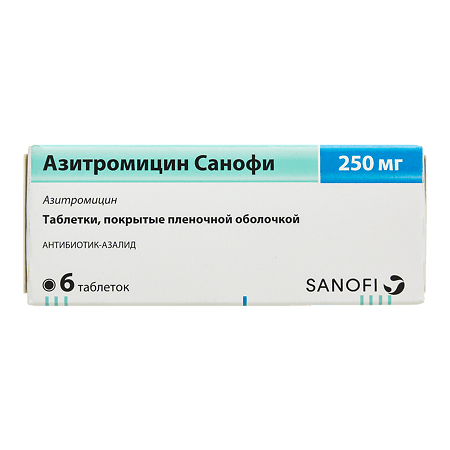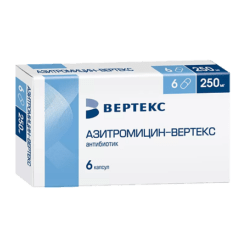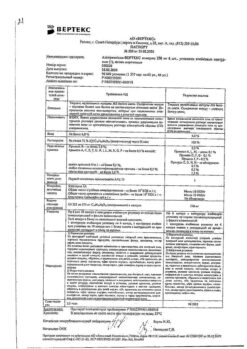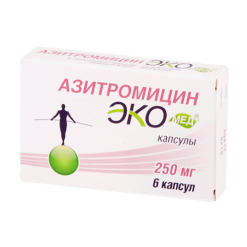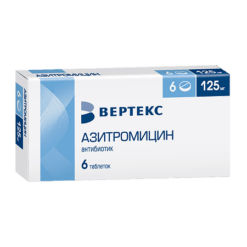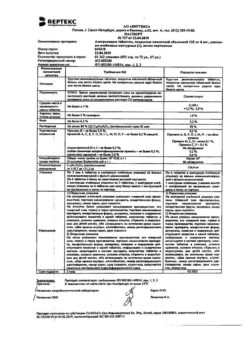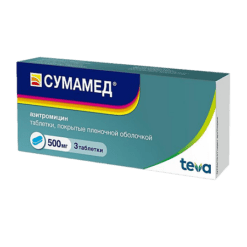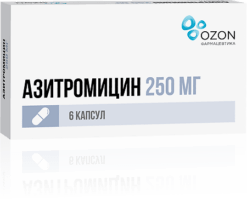No products in the cart.
Sanofi Azithromycin, 250 mg 6 pcs
€1.00
Out of stock
(E-mail when Stock is available)
Description
Sanofi Azithromycin is an antibiotic of the macrolide group and is an azalide. It suppresses RNA-dependent protein synthesis of susceptible microorganisms.
Active against Gram-positive bacteria: Staphylococcus aureus, Streptococcus spp. Streptococcus pneumoniae, Streptococcus pyogenes /group A/); Gram-negative bacteria: Haemophilus influenzae, Haemophilus parainfluenzae, Haemophilus ducreyi, Moraxella catarrhalis, Escherichia coli, Bordetella pertussis, Bordetella parapertussis, Borrelia burgdorferi, Neisseria gonorrhoeae, Campylobacter spp, Legionella pneumophila; anaerobic bacteria: Bacteroides fragilis.
Azithromycin is also active against Chlamydia trachomatis, Mycoplasma pneumoniae, Mycoplasma hominis, Treponema pallidum.
It is also active against Toxoplasma gondii.
Indications
Indications
Infectious inflammatory diseases caused by microorganisms sensitive to azithromycin:
Infections of the upper respiratory tract and ENT (sinusitis, tonsillitis, pharyngitis, otitis media);
Lower respiratory tract infections (acute bronchitis, acute exacerbation of chronic bronchitis, pneumonia, including that caused by atypical pathogens).
Skin and soft tissue infections (moderate acne vulgaris, rye, impetigo, secondary infected dermatoses);
Uncomplicated urinary tract infections caused by Chlamydia trachomatis (urethritis and/or cervicitis);
The initial stage of Lyme disease (borreliosis) – erythema migrans.
Active ingredient
Active ingredient
Composition
Composition
Each film-coated tablet 250 mg contains:
the active ingredient:
azithromycin 250.000 mg (in the form of azithromycin dihydrate – 262.026 mg);
excipients:
kernel:
Corn pregelatinized starch – 42.500 mg, croscarmellose sodium – 9.000 mg, calcium hydrophosphate – 115.625 mg, magnesium stearate – 6.375 mg, sodium lauryl sulfate – 1.500 mg.
coating:
. Hypromellose 2910/5 – 7,300 mg, titanium dioxide – 3,100 mg, macrogol 6000 – 0,700 mg, talc – 1,250 mg, simethicone emulsion SE 4 (water – 67.4%, siloxanes and silicones – 30.0%, methylated cellulose – 2.5%, sorbic acid – 0.1%) – 0.050 mg, polysorbate 80 – 0.100 mg.
How to take, the dosage
How to take, the dosage
Overly, 1 h before or 2 h after a meal, without chewing, once a day.
Adults and children over 12 years of age and weighing more than 45 kg:
– in upper and lower respiratory tract infections, ENT organs, skin and soft tissue infections (except for chronic erythema migrans) – 500 mg/day 1 dose for 3 days (course dose – 1.5 g); – in acne vulgaris of moderate severity: 1 tablet. (500 mg) once a day for 3 days, then 1 tablet (500 mg) once a week for 9 weeks; the course dose is 6 g. The first weekly tablet should be taken 7 days after the first daily tablet (day 8 from the start of treatment), the next 8 weekly tablets – at 7-day intervals; – In acute infections of the urogenital organs (uncomplicated urethritis or cervicitis) – 1 g (2 tablets, 500 mg) once;
– in case of acute urogenital tract infections (uncomplicated urethritis or cervicitis)
– in Lyme disease (borreliosis) for the treatment of stage I (erythema migrans) – 1 g on the first day and from day 2 to 5 – 500 mg daily (cumulative dose – 3 g);
. Elderly patients (age over 65 years)
The same dosages as for adults are used to treat elderly patients. Because elderly patients may have arrhythmogenic factors, special attention should be given to the possibility of cardiac arrhythmias and pirouette ventricular tachycardia.
In case of impaired renal function (creatinine clearance greater than 40 ml/min), no dose adjustment is required.
In case of hepatic impairment: with moderate hepatic impairment no dose adjustment is required.
Interaction
Interaction
Antacids (aluminum- and magnesium-containing), slow down and reduce absorption of azithromycin (for oral forms), therefore the interval between their intake should be 1 h before or 2 h after taking food and the indicated drugs.
When co-administering azithromycin has no effect on the plasma concentration of atorvastatin, but there is a risk of rhabdomyolysis.
When co-administration of warfarin and azithromycin (in usual doses) no changes of prothrombin time were found, however, taking into account that in interaction of macrolides and warfarin there may be increase of anticoagulation effect, patients should be monitored closely for prothrombin time.
When concomitant administration of digoxin and azithromycin it is necessary to monitor blood digoxin concentration, since many macrolides increase digoxin absorption in intestine, thus increasing its concentration in plasma.
When combined with cimetidine 2 hours before azithromycin administration, there is no effect on the pharmacokinetics of azithromycin.
When co-administering azithromycin with rifabutin, the risk of neutropenia should be considered.
There are no data about the effect of azithromycin on the blood concentrations of triazolam, midazolam, efavirenz, fluconazole, indinavir, trimethoprim/sulfamethoxazole when used together, but this should not be excluded, because macrolide interaction with the above mentioned drugs is known.
In co-administration of azithromycin with ergotamine or dihydroergotamine it is possible to increase their toxic effects (vasospasm, dysesthesia). There are no data on possible interaction between azithromycin and derivatives of ergotamine and dihydroergotamine, but because of the development of ergotism when using macrolides with derivatives of ergotamine and dihydroergotamine simultaneously these combinations are contraindicated.
Caution should be exercised when using terfenadine and azithromycin concomitantly, because concomitant administration of terfenadine and different types of antibiotics has been found to cause arrhythmias and prolongation of the Q-T interval. Therefore, these complications cannot be excluded with terfenadine and azithromycin.
When concomitant use with cyclosporine is necessary, it is recommended to monitor the plasma concentration of cyclosporine.
The concomitant use of azithromycin (1200 mg) and nelfinavir (750 mg 3 times daily) causes an increase in the equilibrium plasma concentration of azithromycin. No clinically significant adverse effects have been observed and no dose adjustment of azithromycin is required when used concomitantly with nelfinavir.
In concomitant use with zidovudine azithromycin does not affect pharmacokinetic parameters of zidovudine in blood plasma or renal excretion of it and its metabolite glucuronide, but at the same time concentration of active metabolite – phosphorylated zidovudine – in mononuclear cells of peripheral vessels is increased. The clinical significance of this fact is unclear.
Azithromycin interacts weakly with isoenzymes of cytochrome P450 system. Azithromycin has not been found to be involved in pharmacokinetic interactions similar to erythromycin and other macrolides. Azithromycin is not an inducer and inhibitor of cytochrome P450 isoenzymes.
When used together azithromycin does not affect plasma concentrations of the following drugs: carbamazepine, cimetidine, didanosine, efavirenz, fluconazole, indinavir, midazolam, theophylline, triazolam, cetirizine, trimethoprim/sulfamethoxazole, sildenafil, rifabutin and methylprednisolone.
Special Instructions
Special Instructions
If a dose of Sanofi Azithromycin is missed, the missed dose should be taken as soon as possible and subsequent doses should be taken 24 hours apart.
Hypersensitivity reactions
. As with erythromycin and other macrolides, rare serious allergic reactions have been reported, including angioedema, anaphylactic reactions (rarely fatal), skin reactions such as acute generalized exanthematous pustulosis, Stevens-Johnson syndrome, toxic epidermal necrolysis (rarely fatal), drug rash with eosinophilia and systemic symptomatology (DRESS syndrome). Some of these reactions resulted in recurrent symptoms and required a longer period of observation and treatment. If an allergic reaction occurs, the drug should be discontinued and appropriate therapy administered. After withdrawal of symptomatic therapy, recurrence of allergic symptoms may be observed.
Azithromycin Sanofi should be used at least 1 hour before and 2 hours after taking antacids.
Myasthenia gravis
A worsening of symptoms of myasthenia gravis and the first manifestation of myasthenia gravis syndrome have been reported in patients treated with azithromycin.
Hepatic impairment
Sanofi Azithromycin should be used with caution in patients with mild to moderate hepatic impairment because of the possibility of fulminant hepatitis and severe hepatic failure. Patients with preclinical liver disease or concomitant treatment with hepatotoxic drugs should also be taken into account. In the presence of symptoms of liver dysfunction, such as rapidly increasing asthenia, jaundice, darkened urine, bleeding tendency, hepatic encephalopathy, the drug should be discontinued and liver function tests should be performed.
In mild to moderate renal dysfunction (creatinine clearance > 40 ml/min), treatment with Sanofi Azithromycin should be used with caution and with monitoring of renal function. In the terminal stage of renal failure (creatinine clearance < 10 ml/min) there is an increase of plasma concentration of azithromycin by 33 %.
Ergotine derivatives
Ergotism has occurred in patients treated with ergot derivatives (ergotamine or dihydroergotamine) when taking macrolide antibiotics. There are no data on the possibility of interaction between ergot derivatives and azithromycin. Nevertheless, because of the theoretical possibility of ergotism, the simultaneous use of azithromycin and ergot derivatives is contraindicated.
Prevention of pharyngitis/tonsillitis
Asithromycin is not the drug of choice for the prevention of pharyngitis/tonsillitis caused by Streptococcus pyogenes and the prevention of acute rheumatic fever.
As with other antibacterials, patients on therapy with Sanofi Azithromycin should be screened regularly for the presence of resistant microorganisms and signs of superinfections, including fungal infections.
Pseudomembranous colitis caused by Clostridium difficile
The Sanofi drug Azithromycin should not be used for longer courses than directed, because the pharmacokinetic properties of azithromycin allow a short and convenient dosing regimen to be recommended. When prolonged use of Sanofi Azithromycin, pseudomembranous colitis caused by Clostridium difficile may develop, both as mild diarrhea and as severe colitis. If diarrhea develops during azithromycin therapy, as well as 2 months after therapy termination, clostridial pseudomembranous colitis should be excluded. Drugs inhibiting intestinal peristalsis are contraindicated.
Delayed ventricular repolarization syndrome
Delayed ventricular repolarization syndrome (prolonged QT interval syndrome) increases the risk of arrhythmias (including pirouette arrhythmias) with macrolide therapy. Caution should be exercised when using azithromycin in patients with prolonged QT interval receiving therapy with antiarrhythmic agents of classes IA, III, cisapride, in hypokalemia or hypomagnesemia, clinically significant bradycardia, arrhythmia or severe cardiac insufficiency.
Contraindications
Contraindications
– Hypersensitivity to azithromycin, erythromycin, other macrolides, or ketolides, or other components of the drug;
– Severe hepatic impairment;
– Severe renal impairment (creatinine clearance < 40 ml/min);
– Childhood under 12 years of age with body weight less than 45 kg;
– Breast-feeding period;
– Concurrent use with ergotamine and dihydroergotamine.
Side effects
Side effects
The incidence of adverse reactions was determined in accordance with the classification of the World Health Organization: very common (⥠1/10); common (⥠1/100 and < 1/10); infrequent (⥠1/1000 and < 1/100); rare (⥠1/10000 and < 1/1000); very rare (< 1/10000), frequency is unknown (cannot be calculated based on available data).
Blood and lymphatic system disorders: frequently eosinophilia, lymphocytopenia; infrequently leukopenia, neutropenia; frequency unknown – thrombocytopenia, hemolytic anemia.
Nervous system disorders: frequent – headache; infrequent – dizziness, paraesthesia, impaired sense of taste, somnolence; frequency unknown – hypoesthesia, syncope, seizures, psychomotor hyperactivity, loss of smell (or anosmia), perversion of smell, loss of taste, myasthenia.
Mental disorders: infrequent – insomnia, nervousness; rarely – agitation; frequency unknown – aggressiveness, anxiety, delirium, hallucinations.
Visual organ disorders: infrequent – visual impairment.
Hearing and labyrinth disorders: infrequent hearing impairment, vertigo; frequency unknown – hearing disorders (including deafness), tinnitus.
Cardiac disorders: infrequent palpitations; frequency unknown – QT interval prolongation, pirouette arrhythmia, ventricular tachycardia.
Vascular disorders: infrequent – “rushes” of blood to the face; frequency unknown – decreased blood pressure.
Gastrointestinal disorders: very common – diarrhea; common – nausea, abdominal pain, vomiting; infrequent – dyspepsia, constipation, gastritis, dysphagia, bloating, dry oral mucosa. belching, oral mucosa ulcers. increased salivary gland secretion; common unknown – discoloration of tongue, pancreatitis.
Renal and urinary tract disorders: infrequent increase in plasma urea and creatinine concentrations, dysuria, renal pain; frequency unknown interstitial nephritis, acute renal failure.
Gender and mammary gland disorders: infrequent – metrorrhagia, impaired testicular function.
Immune system disorders: infrequent hypersensitivity reactions, angioedema; anaphylactic reaction.
Skin and subcutaneous tissue disorders: infrequent – skin itching, skin rash, urticaria, dry skin, sweating, dermatitis; rarely – photosensitization reaction, acute generalized exanthematous pustulosis; frequency unknown – erythema multiforme, Stevens-Johnson syndrome, toxic epidermal necrolysis.
Disorders of metabolism and nutrition: infrequent – anorexia.
Infectious and parasitic diseases: infrequent – candidiasis, including oral and genital mucosa, vaginal infections, pneumonia, fungal infections, bacterial infections, pharyngitis, gastroenteritis, respiratory diseases, rhinitis; frequency is unknown pseudomembranous colitis.
Hepatic and biliary tract disorders: rare – hepatic dysfunction, cholestatic jaundice; frequency unknown – hepatic failure (in rare cases with fatal outcome, mainly against the background of severe liver function impairment), liver necrosis, fulminant hepatitis.
Musculoskeletal and connective tissue disorders: infrequent – osteoarthritis, myalgia, back pain, neck pain; frequency unknown – arthralgia.
Respiratory system, thorax and mediastinum disorders: infrequent – nasal bleeding, dyspnea.
General disorders and disorders at the site of administration: infrequent – weakness, chest pain, edema, peripheral edema, asthenia, malaise, facial edema, fever.
Laboratory and instrumental data: frequent – increased number of basophils, monocytes, neutrophils, decreased plasma bicarbonate concentration; infrequent – increased “hepatic” transaminase activity, increased plasma bilirubin concentration, increased alkaline phosphatase activity, increased plasma chloride concentration, increased plasma glucose concentration, increased platelet count, decreased hematocrit, changed plasma sodium content, changed plasma potassium content, increased plasma bicarbonate concentration.
Injury intoxication and complications of manipulation: infrequent – complications after the procedure.
The following is a list of adverse reactions possibly or probably related to the prevention or treatment of infections caused by Mycobacterium Avium Complex that have been identified in clinical studies and post-registration surveillance.
Metabolic and nutritional disorders: often – anorexia.
Nervous system disorders: often – headache, dizziness, paresthesia, taste disorders.
Visual organ disorders: often – visual impairment.
Hearing and labyrinth disorders: frequent – deafness; infrequent – hearing disorders, tinnitus.
Heart disorders: infrequent – feeling of palpitations.
Gastrointestinal disorders: very often – diarrhea, nausea, abdominal pain, abdominal discomfort, vomiting, bloating.
Liver and biliary tract disorders: infrequent – hepatitis.
Skin and subcutaneous tissue disorders: frequently – skin itching, skin rash; infrequently – Stevens-Johnson syndrome, photosensitization reaction.
Musculoskeletal and connective tissue disorders: often arthralgia.
General disorders and disorders at the site of administration: often – weakness; infrequently – asthenia, malaise.
Overdose
Overdose
Symptoms: nausea, temporary hearing loss, vomiting, diarrhea, abdominal pain, liver dysfunction.
Treatment: gastric lavage, symptomatic therapy (taking activated charcoal), control of vital functions.
Similarities
Similarities
Additional information
| Shelf life | 3 years |
|---|---|
| Conditions of storage | Store at the temperature not more than 25 °С. Keep out of reach of children. |
| Manufacturer | Zentiva k.s., Czech Republic |
| Medication form | pills |
| Brand | Zentiva k.s. |
Other forms…
Related products
Buy Sanofi Azithromycin, 250 mg 6 pcs with delivery to USA, UK, Europe and over 120 other countries.

